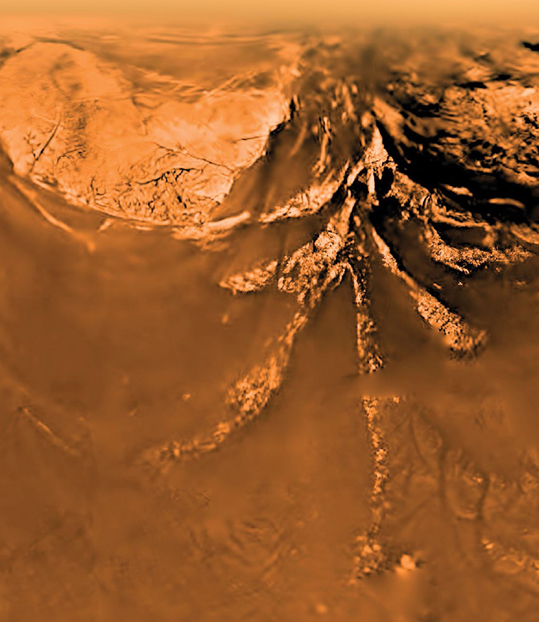2005
Huygens Lands on Titan
Saturn’s moon Titan is the second-largest satellite in the solar system (larger than the planet Mercury) and the only satellite with a substantial atmosphere. Hopes were high that the surface would reveal interesting landforms and processes during the Voyager flybys of Saturn in 1980 and 1981; however, Titan turns out to be shrouded by a thick layer of haze that obscured the surface from view at the visible wavelengths of the Voyager cameras. Spectroscopic data did show that Titan’s atmosphere is made up of mostly nitrogen (N2) with a small amount of methane (CH4), and that it has a surface pressure 50 percent higher than Earth’s pressure at sea level but a temperature only about 90 degrees above absolute zero.
Much was learned about Titan from Voyager data and subsequent telescopic observations, but much remained unknown, motivating a dedicated Titan exploration payload to be added to the Cassini Saturn Orbiter. When Cassini launched in 1997, it carried a Titan lander called Huygens, after Titan’s discoverer, the Danish astronomer Christiaan Huygens.
Huygens completed a successful aerobraking (using friction from the upper atmosphere to gradually lower its orbit) and parachute-assisted landing on January 14, 2005, becoming the first lander on an outer planetary surface. During the descent the probe obtained spectacular photographs of river-like channel systems, shorelines, and dark, flat-floored plains that have been interpreted as lakes of liquid ethane, methane, or propane. The lander survived on the surface for about 90 minutes, taking photographs of the strange alien landscape and measuring the pressure, temperature, and chemistry.

The 4- to 8-inch (10- to 20-centimeter) “rocks” in this artist rendering of the Huygens probe on Titan are pebbles of water and hydrocarbon ices, rounded by transport in streams or lakes of liquid hydrocarbons.
Images of the surface of Titan from Huygens resemble images of the Martian surface in some ways, and Earth’s surface in other ways. But there are substantial differences. For example, the “rocks” in the images are not made of silicates but are likely chunks of water or hydrocarbon ices (which act like rock at very low temperatures), and although the resulting landforms are surprisingly similar, Titan’s river channels and shorelines are carved by liquid hydrocarbons, not liquid water.
SEE ALSO Titan (1655), Organic Molecules in Murchison Meteorite (1970), Voyager Saturn Encounters (1980, 1981), Cassini Explores Saturn (2004–2017).
A flattened (Mercator) projection of the probe’s view of Titan from an altitude of 6 miles (10 kilometers).
